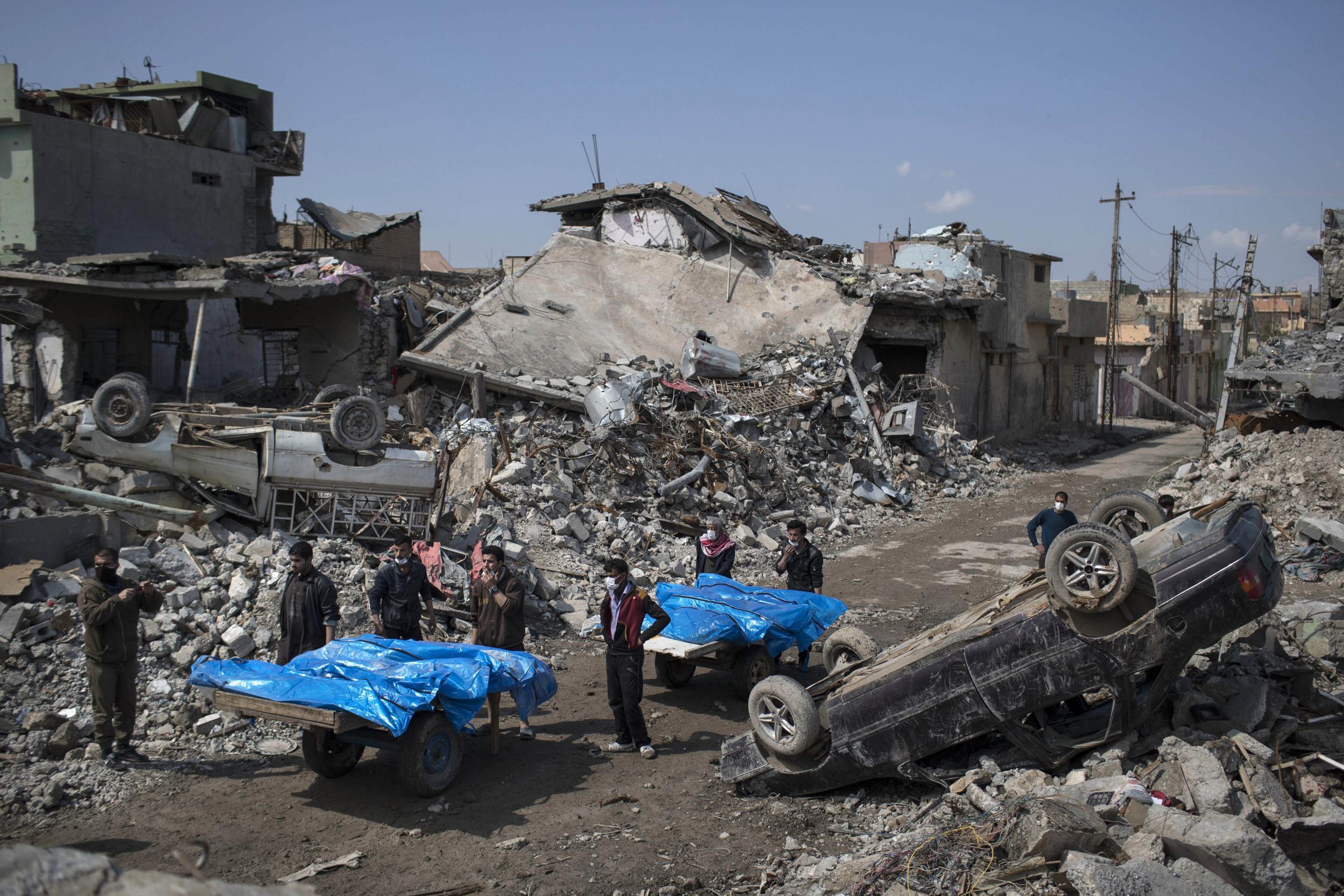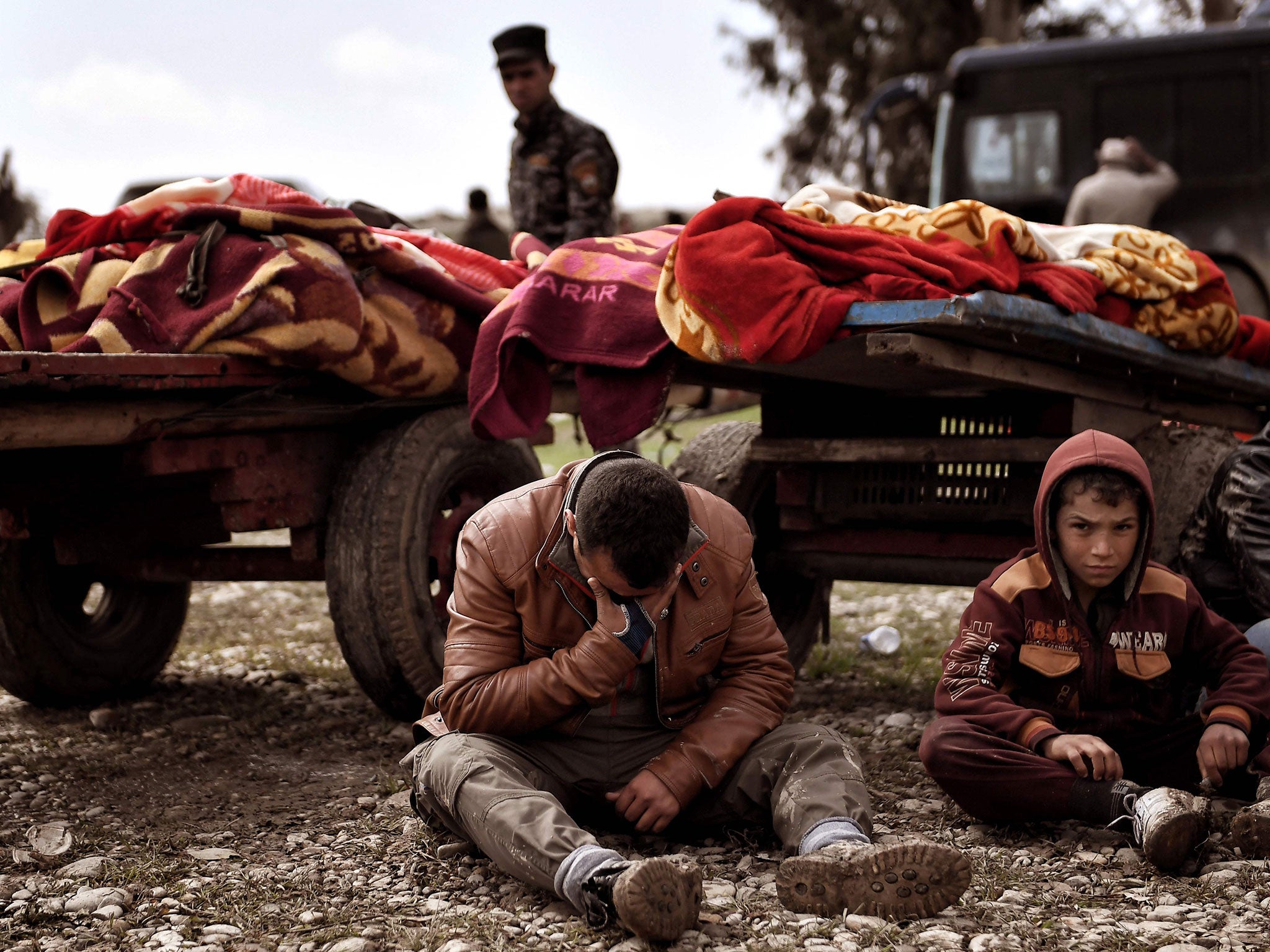US-led coalition Mosul air strike killed up to 240 Iraqi civilians 'because Isis snipers used roof'
Survivors of bombing in al-Jadida say militants used homes despite their pleas

Your support helps us to tell the story
From reproductive rights to climate change to Big Tech, The Independent is on the ground when the story is developing. Whether it's investigating the financials of Elon Musk's pro-Trump PAC or producing our latest documentary, 'The A Word', which shines a light on the American women fighting for reproductive rights, we know how important it is to parse out the facts from the messaging.
At such a critical moment in US history, we need reporters on the ground. Your donation allows us to keep sending journalists to speak to both sides of the story.
The Independent is trusted by Americans across the entire political spectrum. And unlike many other quality news outlets, we choose not to lock Americans out of our reporting and analysis with paywalls. We believe quality journalism should be available to everyone, paid for by those who can afford it.
Your support makes all the difference.Amid growing international alarm over rising civilian casualties in the battle to drive Isis out of Mosul, allegations have emerged that American forces destroyed a cluster of houses packed with families to kill a handful of Isis fighters.
Some survivors of air strikes that killed up to 240 civilians in the al-Jadida district said they had been forced inside by militants, while others were obeying leaflets dropped by Iraqi forces telling them to remain at home during battles.
As hundreds of men, women and children sheltered in rooms and basements, their homes were hit on 13 March and then again four days later, reducing the buildings to rubble.
Several residents said Isis snipers had taken up positions on the roofs of their homes, parked a car bomb outside and set fire to vehicles, believing the militants were the target of the US-led coalition’s firepower.
“Not all of the houses had Daesh [Isis] on the roof,” Ali Abdulghani told the New York Times. “Why, just because of one Daesh, kill everyone?”
Munatha Jasim, who lost nine relatives including her four-year-old daughter and seven-year-old son when her home was destroyed, said a sniper had set up across the street from her house.
“Just because one Isis [fighter] was on our house, the aircraft bombed us,” she told the LA Times.
Na’el Tawfiq Abdel Hafez, whose 23-year-old son Mos’ab was killed in the strike, told Amnesty International they were surrounded by fighting for months, with Isis snipers on rooftops and Iraqi soldiers firing mortars into the district.

“There was nothing we could do, we are civilians; we could not stop Daesh,” he added.
“When they entered my home, shortly before the strike, I tried to challenge them, to plead with them; I told them ‘what are you doing, I have a family here’.
“They left but as they were leaving, the house was bombed.”
The Pentagon previously announced four strikes near Mosul on 17 March, saying they destroyed 25 fighting positions, 56 vehicles and a suicide car bomb.
Journalists, who have since been banned from visiting the site and other parts of western Mosul, saw a pregnant woman and children among at least 50 bodies recovered by Saturday, with limbs and shoes protruding from destroyed houses.
Local estimates of the death toll range between 130 and 240, with the true figure difficult to confirm as the recovery of bodies continues.
The Iraqi defence ministry confirmed that at least 61 civilians died but accused Isis of causing the devastation by rigging the walls of homes with explosives, in a possible move to delay the offensive.
But the US-led coalition has admitted its air strikes hit targets that “correspond to allegations of civilian casualties”, insisting they struck Isis fighters and equipment.
A spokesperson for the US-led Operation Inherent Resolve said an investigation had been opened to determine the “validity” of the claims.
The Pentagon has insisted its rules of engagement had not been loosened amid speculation over a potential link between rocketing civilian casualty reports and Donald Trump’s presidency.
The US’ official civilian death toll from the air campaign against Isis in Syria and Iraq stands at 220, although monitors say the real total is far higher and Airwars warned this week of “record” deaths passing the 1,000 mark.
If confirmed, the al-Jadida strike would be one of the deadliest single incidents for civilians in recent memory in any major conflict involving the US, which has repeatedly boasted of waging the “most precise air campaign in history” against Isis.
Casualties caused in the incident and many others in western Mosul forced a temporary pause in the advance by Iraqi government forces over the weekend.
Iraq’s federal police announced a new advance into south-western parts of the Old City on Monday, heading towards the al-Nuri mosque where Isis leader Abu Bakr al-Baghdadi declared the formation of his “caliphate” in 2014.
Amnesty International accused the US-led coalition and its allies for failing to take adequate precautions to prevent civilian deaths in densely populated parts of Mosul, possibly amounting to a “flagrant violation of international humanitarian law”.
Residents told the group civilians had been killed by coalition air strikes as well as indiscriminate mortar fire by both Isis and Iraqi forces.
“The fact that Iraqi authorities repeatedly advised civilians to remain at home instead of fleeing the area, indicates that coalition forces should have known that these strikes were likely to result in a significant numbers of civilian casualties,” said the group’s senior crisis response adviser Donatella Rovera.
Mohammed, a resident of the Hay al-Dhubbat district who lost several relatives in a coalition air strike, told Amnesty Isis fighters were “everywhere” and any residents who attempted to stop them using their homes were killed.
“They ran this city for years and they were rarely targeted during all that time,” he added.
“Why now [are they] destroying our homes with our families inside, just to eliminate two or three [Isis fighters] on the roof?”
The UN also it was “profoundly concerned” by the reports emerging from al-Jadida, calling for all parties to do everything possible to protect civilians as an estimated 400,000 people remain trapped in dire humanitarian conditions in Mosul.
At at least 307 people were killed and another 273 wounded between 17 February and 22 March, according to UN figures, with the deadliest single incident on 17 March.
Isis has been fortifying Mosul for almost three years and its militants are deploying suicide car bombs, mines, booby traps, ambushes, mortars and drones to defend their last city stronghold in Iraq.
Faced with their toughest battle yet, Iraqi and coalition forces have increasingly turned to air strikes and artillery to clear and hold territory in densely-populated western districts.
Progress has faltered in the last two weeks as fighting enters the narrow alleys of the Old City, where thousands of civilians have been fleeing every day.
Those attempting to cross the Tigris River told The Independent people were being shot dead on bridges by both Isis as it tries to keep its human shields in place, and Iraqi army snipers suspicious of Isis “infiltrators”.
Join our commenting forum
Join thought-provoking conversations, follow other Independent readers and see their replies
Comments